“Greetings from the Country”: the University of Washington Libraries Postcard Collection

The Postcard Collection originated with the personal accumulation of a faculty member, Prof. Caroline Ober, who taught Spanish at the university from 1897 to 1929. Ober was a notable victim of the postcard-collecting craze that swept the nation at the beginning of the twentieth century, and she initiated postcard trades with dozens of other collectors around the world. She also used postcards to maintain ties with former pupils, and with her well-traveled family.
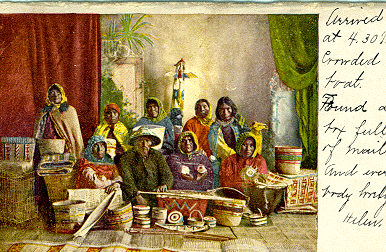
Although worldwide in scope, the Ober collection was especially strong in cards from the Pacific Northwest, British Columbia, and Alaska, and that regional emphasis continues with today’s collecting. There are approximately 57,771 postcards in Special Collections, about 20% of which relate to the Pacific Northwest. About 90% of the postcards are arranged by topic or locality, an organization that is not ideal but is at least workable.
The Pacific Northwest postcards are especially strong in images depicting Native Americans, architecture and the built environment, transportation, town and city scenes, and depictions of industries such as logging and agriculture. The worldwide holdings include major European nations such as Germany, France, and Italy, as well as smaller groups from such places as Russia, Japan, China, South Africa, Argentina, Egypt, and so forth. Many cards commemorate holidays, promote political campaigns or stage plays, advertise goods, convey best wishes or thoughts for a happy birthday, or reproduce notable artworks. Special Collections also acquires cards that use unusual materials (such as wood, metal, leather, fabric, etc.), that demonstrate particular printing processes, or that are graphically striking or unusual.
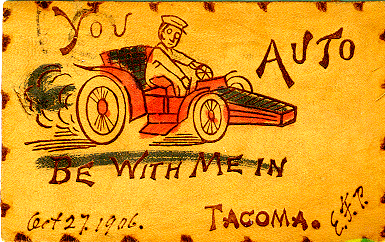
As pieces of paper ephemera, postcards are frequently overlooked as sources of information or as a significant research tool, but their value is increasingly apparent. Postcards are not only illustrative, but, in quantity, they also serve as markers of popular taste and attitudes. Despite the obvious possibility of inauthenticity, postcards are often highly appealing because they provide the only image of a building or scene that is in color. The increasing ease of color reproduction, too, is altering our perception of the informational value of images.

Examining the postcards of a town or city can pinpoint what features or characteristics were considered to be distinctive or valuable. Postcard publishers issued cards that would appeal to tourists. However, they also wanted them to interest the residents, who frequently mailed cards to friends and relatives who might never visit the place. Cards depicting public buildings, railroad stations, parks, and busy streets were, in effect, benchmarks of civic achievement. They enabled both visitors and out- of-towners to see exactly how well their city compared with others.
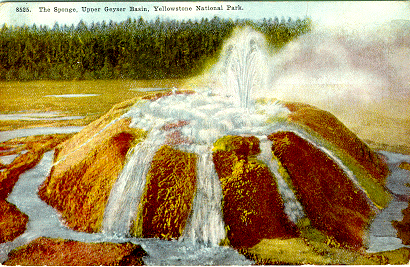
UW Libraries exhibits frequently use postcards, and one was devoted to them: “‘Hope to be there on Monday’: the Postcard and the Western Traveler.” Postcard images and messages were used along with tourist brochures and booklets, snapshots, and souvenirs, to depict the changing role of tourism in the American West as the automobile became the major mode of travel. Among the prominent themes of the exhibit was American society’s fascination with certain aspects of Western scenery. The largest trees, the highest falls, the deepest canyons, the most colorful geothermal pots, the most convoluted and contorted landscapes: the West of the postcard was a phantasmagoria of nature.
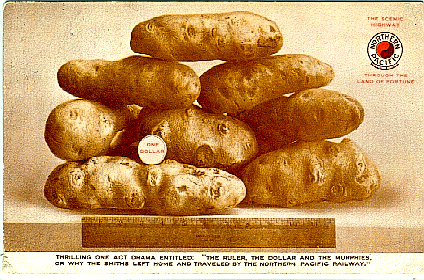
Other Special Collections exhibits have made good use of postcards, such as those on the railroad influence on Pacific Northwest settlement patterns (many railroad-issued cards promoted agricultural and industrial opportunities), the sesquicentennial of the Oregon Trail, the history of the area’s hotels and the hospitality business, the place of mountains and mountaineering in regional consciousness, and the role of the idea of “the frontier” in the Pacific Northwest.
“Yugoslavian Costume: A Tribute to Blanche Payne” was a University Libraries exhibit that included many postcards. Payne was a pioneer costume historian and University professor who traveled in what was then Yugoslavia in the 1930s, collecting textile and costume samples, taking photographs, commissioning sketches, and collecting postcards that documented regional costume. The recent destruction of libraries and other cultural repositories in this region has given Payne’s collection, including her postcards, an unanticipated value and importance.
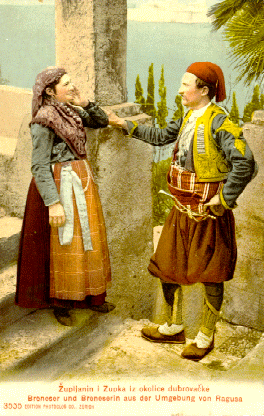
Pacific Northwest Quarterly carried a short piece on our postcard collection in its July 1992 issue. The same issue featured an article describing a 1924 transcontinental auto tour. It included seven postcard views from our collection, such as the scene of the spectacular highway loops approaching Lewiston, Idaho, in the canyon of the Snake River a street scene in the small town of Hood River, Oregon; and the bungalow-style Garden Courts Tourist Park in Boise, Idaho.
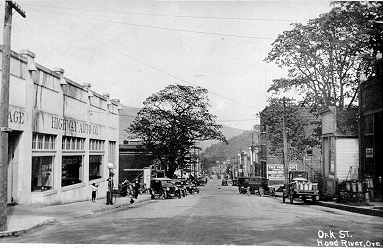
A lecturer on vernacular architecture used postcard views of Main Street scenes, mining structures, and motels to make slides for a class presentation. An anthropology graduate student culled the collection for risque images, for a study of popular attitudes about sex. A graduate student in art history surveyed the postcards for depictions of Native American women in stereotyped situations, such as poses that suggest the Madonna and child; these too are reflective of popular perceptions. The messages on such cards often provide additional bits of evidence about popular attitudes: “This is quite Western, isn’t it? Did you ever see an Indian squaw? We see them here in Seattle in numbers about hop-picking time.”
 |
|
|---|
As that quotation also suggests, cards raise questions as often as they help answer them. There is surely an explanation for the fact that during the 1910s, for example, Halloween cards frequently carried a romantic message along with (or in place of) one tied to black cats and witches. Other holidays such as St. Patrick’s Day also exhibit romantic overtones on postcards. The iconography of postcards, along with other popular published images, is due for some study.
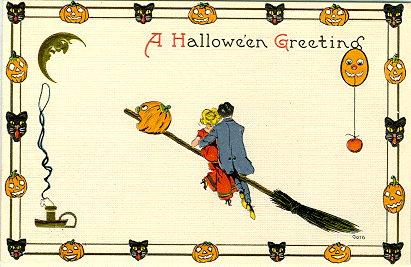
Postcards are visual tidbits and pop culture touchstones, and they are documentations of small-town streets and local industries. Postcards can also be used to seriously address other historical and aesthetic issues, especially when researchers can examine and evaluate dozens or hundreds of examples, as they can in a collection of this size and scope. It is a rich historical and visual record.
A longer version of this article appears as “Pacific Northwest and Other Post card Treasures in the University of Washington Libraries,” by Richard H. Engeman, in Postcards in the Library: Invaluable Visual Resources, edited by Norman D. Stevens (Haworth Press, 1995); also published as Popular Culture in Libraries, vol. 3, #2 (1995).
